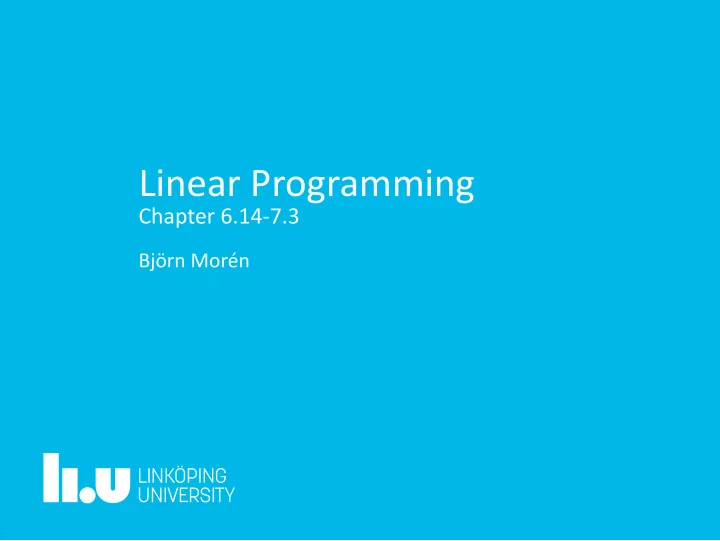

Linear Programming Chapter 6.14-7.3 Björn Morén
1 Simplex Method with Upper Bounds Optjmality Conditjons Simplex Method 2 Interior Point Methods
1 Simplex Method with Upper Bounds Optjmality Conditjons Simplex Method 2 Interior Point Methods
Linear Programming Björn Morén December 15, 2016 3 / 22 Problem Formulatjon 1. Upper bounds as constraints 2. Consider upper bounds implicitly
Linear Programming Björn Morén December 15, 2016 4 / 22 Basic Solutjon Divide variables if they are basic, at lower bound, or at upper bound ( x B , x L , x U )
Linear Programming Björn Morén December 15, 2016 5 / 22 Dual Problem
Linear Programming Björn Morén December 15, 2016 6 / 22 Optjmality Conditjons and Dual Feasibility Reduced costs are defined as ¯ c j = πA ,j
Linear Programming Björn Morén December 15, 2016 6 / 22 Optjmality Conditjons and Dual Feasibility Reduced costs are defined as ¯ c j = πA ,j
Linear Programming Björn Morén December 15, 2016 7 / 22 Updated Simplex Method 1. Check optimality conditions 2. Select entering variable 3. Minimum ratio test (and select exiting variable) 4. Do pivot step
Linear Programming Björn Morén December 15, 2016 8 / 22 Updated Simplex Method 1. Check optimality conditions 2. Select entering variable 3. Minimum ratio test (and select exiting variable) 4. Do pivot step
Linear Programming Björn Morén December 15, 2016 9 / 22 Optjmality Conditjons Solution is optimal if 1. For all x j at lower bound, x j = l j reduced cost c j ≥ 0 ¯ 2. For all x j at upper bound, x j = u j reduced cost c j ≤ 0 ¯
Linear Programming Björn Morén December 15, 2016 10 / 22 Minimum Ratjo If the entering variable x s is at lower bound: 1. x s = θ g − θ ¯ 2. x B = ¯ A ,s
Linear Programming Björn Morén December 15, 2016 11 / 22 Minimum Ratjo If the entering variable x s is at upper bound: 1. x s = - θ g + θ ¯ 2. x B = ¯ A ,s
Linear Programming Björn Morén December 15, 2016 12 / 22 Phase I To find a feasible solution, a standard Phase I method can be used.
1 Simplex Method with Upper Bounds Optjmality Conditjons Simplex Method 2 Interior Point Methods
Linear Programming Björn Morén December 15, 2016 14 / 22 History Dikin 1967 was first. Khachiyan 1979, ellipsoid algorithm, solves Linear Programs in polynomial time. Work by Karmakar 1984 made it popular. Also solves Linear Programs in polynomial time, more effective than the ellipsoid algorithm.
interior point if Linear Programming Björn Morén December 15, 2016 15 / 22 Interior Point
Linear Programming Björn Morén December 15, 2016 15 / 22 Interior Point x interior point if
relative interior point if Linear Programming Björn Morén December 15, 2016 16 / 22 Relatjve Interior Point
Linear Programming Björn Morén December 15, 2016 16 / 22 Relatjve Interior Point x relative interior point if
Find a solution from the following Phase I problem Linear Programming Björn Morén December 15, 2016 17 / 22 Phase I - examples
Linear Programming Björn Morén December 15, 2016 17 / 22 Phase I - examples Find a solution from the following Phase I problem
Find a solution from the following Phase I problem Linear Programming Björn Morén December 15, 2016 18 / 22 Phase I - examples
Linear Programming Björn Morén December 15, 2016 18 / 22 Phase I - examples Find a solution from the following Phase I problem
Find a solution from the following Phase I problem Linear Programming Björn Morén December 15, 2016 19 / 22 Phase I - examples
Linear Programming Björn Morén December 15, 2016 19 / 22 Phase I - examples Find a solution from the following Phase I problem
Linear Programming Björn Morén December 15, 2016 20 / 22 Rounding Procedure Theorem 1 (7.1) . if x is sufficiently close to the optimal objective function value. An optimal basic feasible solution can be found by using the purification routine.
2. Determine step length Linear Programming Björn Morén December 15, 2016 21 / 22 General Algorithm 1. Find search direction 1. Solving approximation problems e.g affine scaling method, Karmarkars projective scaling method 2. Solving a problem with optimality conditions, nonlinear equations, e.g primal-dual path following IPM
Linear Programming Björn Morén December 15, 2016 21 / 22 General Algorithm 1. Find search direction 1. Solving approximation problems e.g affine scaling method, Karmarkars projective scaling method 2. Solving a problem with optimality conditions, nonlinear equations, e.g primal-dual path following IPM 2. Determine step length
Linear Programming Björn Morén December 15, 2016 22 / 22 Observatjons • Number of iterations grow very slowly with problem size, almost constant • Time per iteration increases with problem size • Extra steps required to get a BFS (purification routine) • Useful on large scale problems • Simplex method is good to start with for understanding
Questjon? www.liu.se
Recommend
More recommend